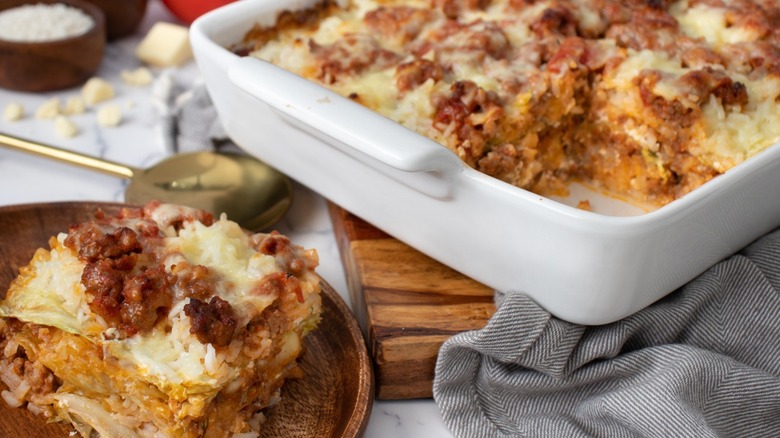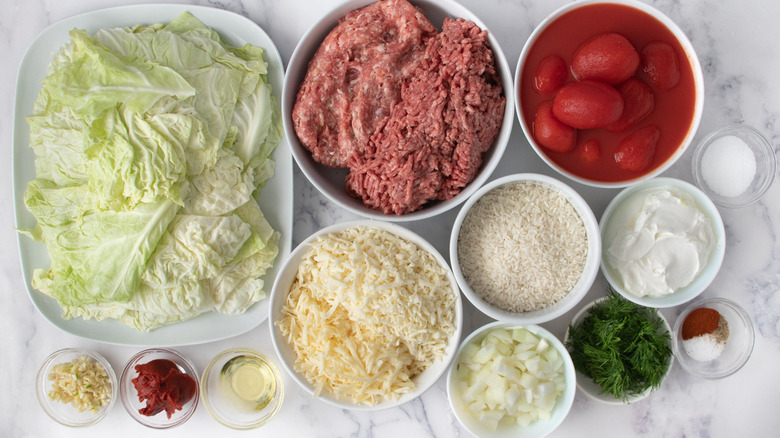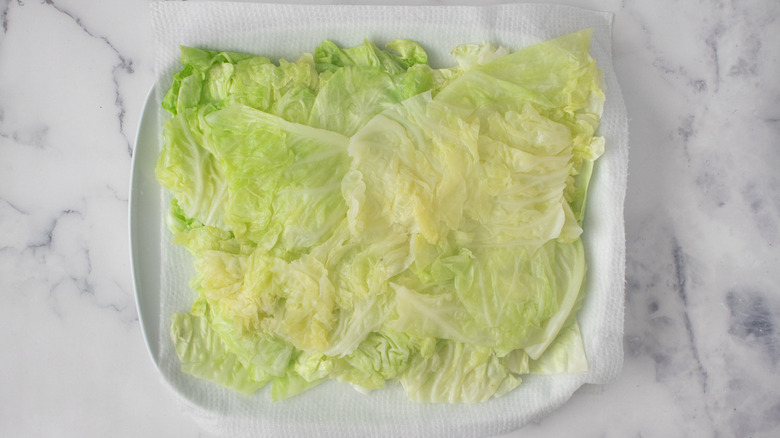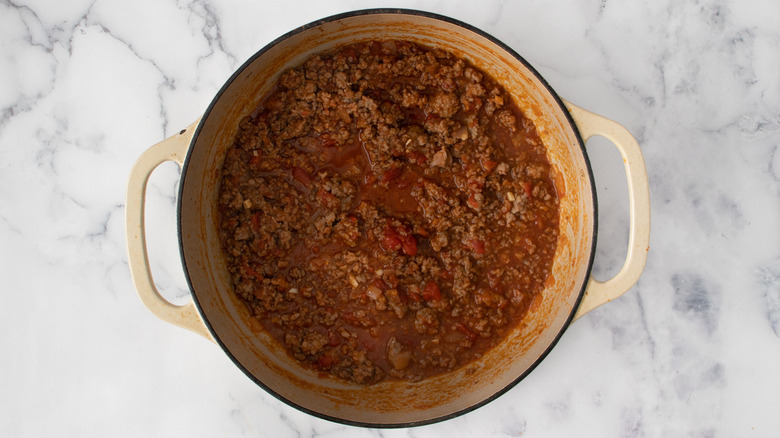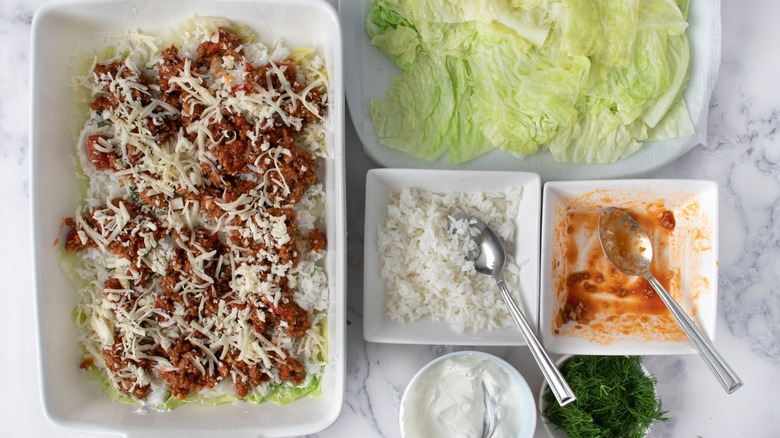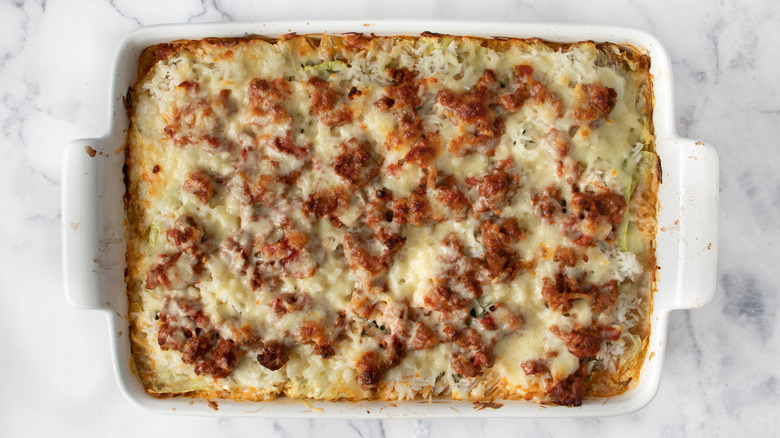Unstuffed Cabbage Roll Casserole Recipe
Cabbage rolls are known across several cultures but seem to be particularly popular in Central and Eastern Europe as two of the best-known versions are Polish golabki and Ukrainian holubtsi. As recipe developer Patterson Watkins points out, though, making these rolls the traditional way "is not a quick process." Taking the cabbage leaves and what would be the fillings and layering them, casserole-style, to make what she calls a "delicious mash-up of classic stuffed cabbage rolls and baked lasagna" is something that she feels can eliminate a lot of the mess and bother.
Feel free to customize this recipe to suit your own personal preferences. Watkins uses a mixture of ground beef and pork sausage but says you can go with just one or the other of these. She also points out that, of course, "plant-based ground meat substitute will work, too." You can also go all one way or the other with the Gruyere/mozzarella cheese combo she favors, or, if you don't care for either cheese, you could opt for Swiss or jack cheese or even pepper jack for a slight hint of heat.
Gather the ingredients for the unstuffed cabbage rolls
Watkins makes this recipe using Savoy cabbage as she says it cooks more quickly than the green kind. You can certainly use the latter if you wish, but there is one caveat: Watkins notes that "Green cabbage leaves might take upwards of 10 minutes, under boil, to reach that pliable tenderness" so you'll need to tack on some extra cooking time. Alternatively, you could take a tip from Rachael Ray and skip the cabbage cooking altogether: Ray asserts that freezing and then defrosting the cabbage as they do in Poland works just as well as boiling.
The other ingredients you'll need for this casserole include salt, rice, olive oil, an onion, garlic, ground beef, sausage meat, canned tomatoes, tomato paste, paprika, black pepper, sour cream, dill, mozzarella, and Gruyere. While Watkins uses fresh dill here, she says it's okay to leave this herb out or else use dried dill if need be. In the latter case, Watkins notes that the proper amount would be "a sparse tablespoon" of the dried stuff.
Cook the cabbage and rice
Fill a pot with water — not up to the brim, of course, just ¾ of the way should do it. Add a tablespoon of salt and boil the water over high heat. Once it's boiling, drop in five or six cabbage leaves and boil them for 2 to 3 minutes, until they're floppy. Drain the cabbage on paper towels and keep repeating the process until all of the cabbage leaves have been cooked.
Pour the rice into the same pot of boiling water (no point waiting for another one to heat up), then boil the rice for 15 minutes, stirring now and then. When the rice is tender, drain it, run it under some cool water, and spread it out in a single layer to dry and cool.
Make the meat filling
Heat the olive oil over medium-high, then fry the onions and garlic for 2 to 3 minutes. Once the aromatics are, well, aromatic, add the meat and stir to break up the clumps. Cook it for 10 to 15 minutes, stirring every once in a while, until it no longer looks pink.
Add the canned tomatoes, breaking them up into smaller pieces with a fork or spoon. Cook them with the meat for 20 minutes until half of the liquid has evaporated. At this point, add the tomato paste, pepper, paprika, and remaining salt. Cook the meat mixture for another 5 minutes, then turn off the stove burner.
Construct the casserole
Preheat the oven to 350 F and grease a 9x13-inch pan. Cover the bottom of the pan with a single layer of cabbage leaves, then spread the cabbage with 3 to 4 tablespoons of sour cream. Follow this with 1 tablespoon of dill (or 1 teaspoon dried), ¾ cup of rice, 1 cup of the meat mixture, and ¾ cup of cheese. If you're using two types of cheese as Watkins does, this will be about 6 tablespoons of each. She notes that you should mix them together at this point so each layer will have both kinds of cheese.
Top the cheese layer with more cabbage leaves, then press down on these to compact the casserole. Follow up with more sour cream, dill, rice, meat, and cheese in this order, then repeat the process once more until you have three layers.
Bake the casserole
Cover the pan with foil, then bake the casserole for 40 minutes. Take the casserole out of the oven, but instead of turning off the appliance, crank the heat up to 425 F. Once it's hot enough, return the casserole to the oven, this time without its foil topper. Bake it for 20 more minutes until the cheese is brown and bubbling, then let it cool for 15 to 30 minutes before cutting into it.
While leftover cabbage casserole can be refrigerated, freezing is recommended for longer-term storage. Watkins tells us, "I prefer portioning the baked casserole into single servings," explaining "that way you can just thaw and reheat what you need."
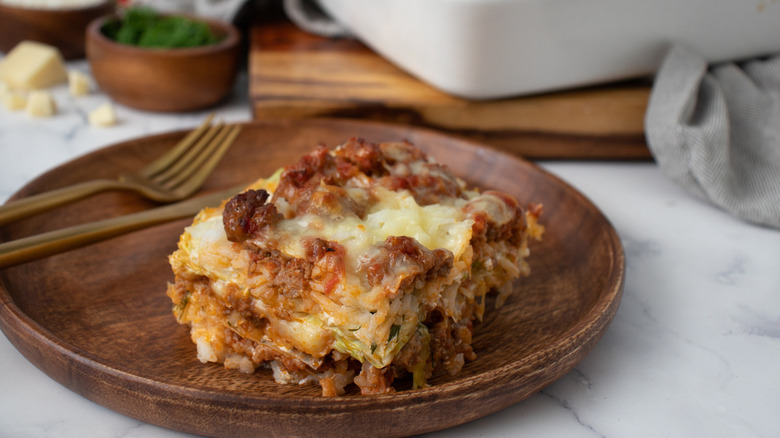
- 4 teaspoons salt, divided
- 1 head savoy cabbage, leaves separated and ribs removed
- 1 ½ cup long-grain white rice
- 1 tablespoon olive oil
- ¾ cup diced yellow onion
- 4 garlic cloves, minced
- 1 pound ground beef
- 1 pound ground Italian sausage
- 1 (28-ounce) can whole peeled tomatoes in juice
- 2 tablespoons tomato paste
- 1 teaspoon paprika
- ¼ teaspoon black pepper
- 1 cup sour cream
- ¼ cup chopped fresh dill
- 6 ounces (about 1 ½ cup) grated Gruyere
- 6 ounces (about 1 ½ cup) grated mozzarella
- Fill a large pot ¾ of the way with water, add 1 tablespoon of salt, and bring the water to a boil over high heat.
- Boil 5-6 cabbage leaves at a time for 2-3 minutes or until tender. Drain the cooked cabbage on paper towels.
- Once all of the cabbage is cooked, add the rice to the same cooking water and boil for 15 minutes until tender, stirring occasionally.
- Drain the rice and rinse it under cold water, then spread it out in an even layer to dry out and cool.
- Heat the olive oil over medium-high heat, then fry the onion and garlic for about 2-3 minutes until fragrant.
- Add both the ground beef and Italian sausage to the onions and garlic and cook, stirring occasionally and breaking up any large clumps, for 10-15 minutes or until no longer pink.
- Stir in the tomatoes, breaking them up into smaller pieces as you do so.
- Simmer the meat and tomatoes for 20 minutes, uncovered, until half of the liquid has evaporated.
- Stir the tomato paste, paprika, and black pepper into the meat along with the remaining salt.
- Simmer the meat for 5 more minutes, then turn off the heat.
- Preheat the oven to 350 F and grease a 9x13-inch baking pan.
- Line the bottom of the pan with a single layer of cabbage leaves and spread these with 3 tablespoons of sour cream.
- Sprinkle 1 tablespoon of dill over the sour cream and top it with ¾ cup of cooked rice.
- Top the rice with 1 cup of meat sauce followed by ¾ cup of cheese (if using both cheeses, mix them together).
- Top the meat and cheese with another layer of cabbage leaves, pressing down to compact the ingredients.
- Follow up with 2 more layers of cabbage, sour cream, dill, rice, meat sauce, then cheese (in this order).
- Cover the casserole with aluminum foil and bake it for 40 minutes.
- Take the casserole out of the oven and increase the heat to 425 F.
- Return the casserole to the oven and bake, uncovered, for 20 more minutes until it appears light brown and bubbly.
- Let the casserole rest for 15-30 minutes before you cut into it.
Nutrition
| Calories per Serving | 699 |
| Total Fat | 44.5 g |
| Saturated Fat | 19.4 g |
| Trans Fat | 1.0 g |
| Cholesterol | 136.5 mg |
| Total Carbohydrates | 40.5 g |
| Dietary Fiber | 3.3 g |
| Total Sugars | 6.0 g |
| Sodium | 859.6 mg |
| Protein | 33.6 g |
